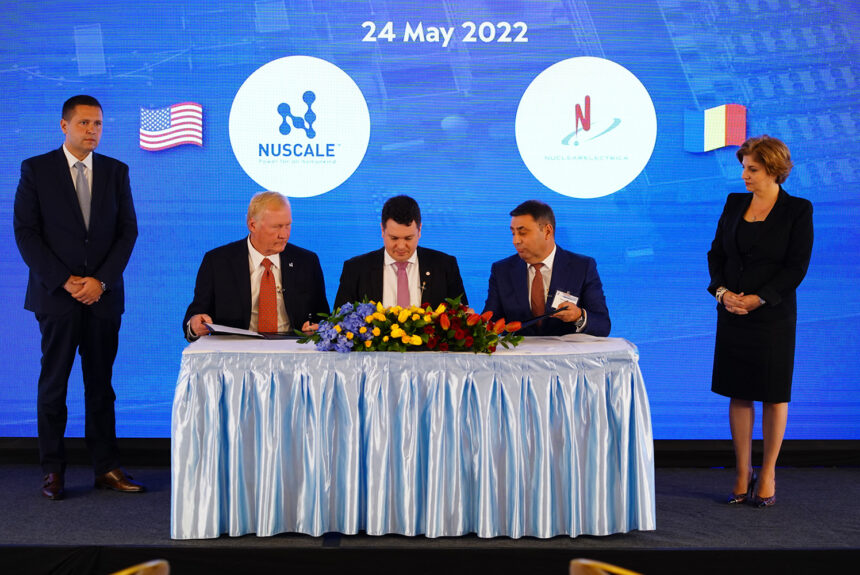During COP26 in November 2021, American nuclear power company NuScale signed a teaming agreement with Romanian energy company Societatea Nationala Nuclearelectrica SA (SNN SA) to develop a 6-module VOYGR-6, 462 MWe, power plant in Romania. This small modular nuclear reactor (SMR) plant is scheduled to come online by 2028, and reduce the nation’s carbon emissions by four million tonnes a year. Ventures like this, and NuScale’s other projects in Bulgaria, the Czech Republic, Poland, Ukraine, and the UK, bring SMRs closer to commercial viability. With nuclear fusion also seeing increased investment and improvements, is the age of a global nuclear technological revolution imminent?
>>>READ: America Could Run On Spent Nuclear Fuel…If We Let It
The International Energy Agency explains that SMRs are nuclear fission reactors with 300 MW(e) capacity—one third of that of conventional reactors. The benefit of these lower-capacity generation sites are their rapid assembly potential: with systems and components able to be prefabricated, factory-assembled, and transported to sites as units ready for instant installation. Their smaller size, cost, and material requirements make them a viable alternative to conventional 700+ MW(e) capacity reactors (as seen in The Simpsons) in remote or land-scarce locations. They can also operate for a thirty-year lifecycle, with less frequent refueling—three to seven years, instead of one to two.
These improvements in cost-efficiency and construction time make nuclear a more immediate alternative to renewables for decarbonising energy production and decoupling from supply chains strangled by adversarial nations. Even the European Parliament, after Germany’s disastrous de-nuclearizing policies, has come around to recognising nuclear as a sustainable ‘green’ energy source. Had Germany spent its renewables budget on expanding its nuclear capacity, it would have been a net energy exporter by now. Instead, battery storage capacity and generation deficits left the country afflicted by brownouts and forced to spend more on Nord Stream 2 than NATO to meet energy needs.
Nuclear fusion too may be moving from theory to being an infrastructural reality. Nuclear fusion reactions occur at a nucleus level: when two positively charged nuclei collide at speeds fast enough to overcome electrostatic repulsion. The frequency of fusion reactions is catalysed by increased temperatures—above 150 million Kelvin. When hydrogen isotopes, like deuterium and tritium, collide and fuse successfully, heat and radiation are produced. Lighter hydrogen nuclei release more energy per unit mass and have a lower repulsion barrier, making them more desirable for fusion reactors.
In the last year, thirty-three fusion companies have attracted $4.8 billion in investment. The UK has become the first country in the world to legislate a regulatory framework for fusion with its Energy Security Bill. Its Energy White Paper dedicated £385m in an Advanced Nuclear Fund to create £400bn in SMRs by 2035. It may also look to fund this via a Regulated Asset Base (RAB) model – incorporated as per my and others’ suggestion into the Nuclear Energy (Financing) Act 2022. RABs allow energy companies to factor the costs of plant construction into the bills for energy produced by existing sources over the SMR’s construction period. Combined with energy levy reductions, consumers would see marginal short-term increases in energy bills, for long-term reductions in energy bills and carbon emissions.
>>>READ: The UK Forges a Global Path to Nuclear Fusion
The Biden Administration has issued a press release on their ‘Bold Decadal Vision for Commercial Fusion Energy’, dedicating $50 million to technology for the eventual construction of a fusion pilot plant. Though, with private investment into fusion energy outpacing government funding for the first time, government subsidy measures seem redundant for a growing market. At a minimum, public expenditures should be kept to deploying first-of-its kind reactors and phased out when technologies are scaled. It may also be entangled in ideological electoral promises, like ‘climate justice’ and ‘diversity, equity, inclusion, and accessibility commitments. These impede progress on achieving vital innovations, adding a burden of compliance with unrelated, expensive, and non-meritocratic social regulations. Instead, a moratorium on income tax for investment returns on low-carbon infrastructure projects and transparent, efficient permitting processes could unlock and attract the private capital vital to getting SMR and fusion projects going.
The UN’s Intergovernmental Panel on Climate Change recognises nuclear power will play an instrumental role in a diversified and decarbonised energy grid. The Climate Change Committee states that the pathway to Net Zero for nations like the UK includes 10 GW of nuclear power capacity by 2035. Anti-nuclear activists should get on the same page as international research and governing bodies, and accept that SMRs and fusion could be the conduit to humanity’s cleaner, greener future.
Connor Tomlinson is the Head of Research for the British Conservation Alliance. He appears regularly in American Spectator and on talkRadio. Follow him on Twitter: @Con_Tomlinson
The views and opinions expressed are those of the author’s and do not necessarily reflect the official policy or position of C3.
